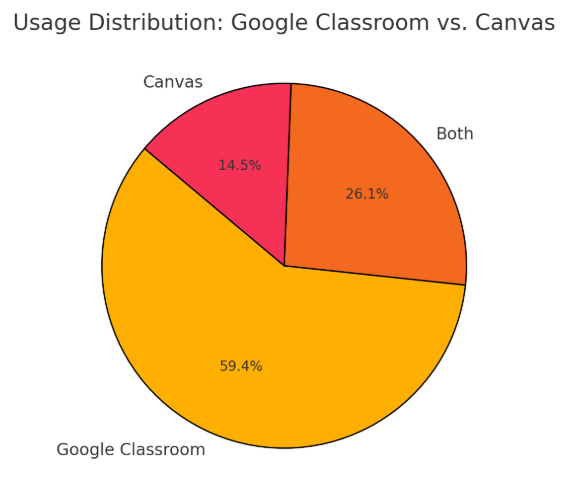
Since the shift to online learning during the COVID-19 pandemic, teachers and students have debated which Learning Management System (LMS) is best: Google Classroom or Canvas. For context, teachers turned to Google Classroom immediately after the shift from paperwork to online learning. Over time, some teachers began utilizing a different LMS called Canvas, which is primarily used in colleges but is also widely adopted in K–12 schools. As of early 2024, Canvas is one of the most widely adopted LMS platforms in the U.S. K–12, tying with Google Classroom. When considering student enrollment, though, Canvas wins, indicating its stronger presence in larger school districts. Technically, both systems existed simultaneously, but the push from CNUSD during the COVID-19 pandemic was for teachers to use Google Classroom for K–12. We now find ourselves debating between Google Classroom and Canvas, and people are very opinionated about their preferences.
Understanding the Teacher’s Perspective
Teachers’ ongoing debate on these two learning management systems is constituted by preference, effectiveness, and efficiency.
A mixed-methods (qualitative and quantitative) survey was sent to all teachers at Santiago High School in Corona, CA, to investigate their perspectives on Google Classroom and Canvas, with the option to select either platform or both. Sixty-nine responses were received, which is roughly two-thirds of all staff at Santiago High School. Results showed that 59.42% of teachers (41 teachers) at Santiago High School used Google Classroom, and 14.49% used Canvas (10 teachers). 26.09% reported using both (18 teachers). Furthermore, 37 teachers preferred Google Classroom, while 28 preferred Canvas or had neutral/mixed opinions.
Teachers’ Perspectives on Canvas and Google Classroom
| Participants | Core Subjects | Google Classroom | Both | Canvas |
| 15 | ELA | 60% | 20% | 20% |
| 7 | History | 71.44% | 14.28% | 14.28% |
| 15 | Math | 73.33% | 20% | 6.67% |
| 7 | Science | 42.85% | 14.29% | 42.86% |
| 8 | World Language | 100% | 0% | 0% |
Google Classroom vs. Canvas
Regarding preference, most teachers find Google Classroom to be more straightforward to navigate. Teacher’s note: “Google is easy to use, and that is what I was trained on, so I am just going with it”, and “I prefer Google Classroom because it is easier and more intuitive.” On the other hand, teachers acknowledge that Canvas is more challenging to navigate; however, it offers more features: “Google Classroom is very easy to use, but its features are fundamental. I’d like to switch to Canvas because it has more to offer teachers.”
The survey responses also evaluated the effectiveness and efficiency of each Learning Management System (LMS). For instance, most teachers reported on the efficacy of Canvas for grading and feedback, as well as academic integrity tools. Many teachers who prefer Canvas touch on how “all assignments and grading are completed through Canvas, using the integration of Turnitin for plagiarism checking and Brisk”. In contrast, others emphasize “Canvas’s lockdown browser for secure online testing.” Google Classroom, on the other hand, is favored for organizing notes and daily materials. “I post all of my notes, assignments, and materials in Google Classroom so students can easily view everything they are responsible for each week.” Teachers also note its effectiveness in promoting collaborations on assignments and integrating with other tools like Delta Math and Desmos.

What Do Students Need from an LMS
Students highlight what they find most necessary in a digital workspace, and that is organization, accessibility, usability, reminders, communication with teachers, integration with other tools, and feedback.
Students need an LMS that displays due dates, assignments, and announcements to ensure they submit work on time and stay up to date on tasks, reminders, and important updates. The primary function of an LMS is for teachers to send out work and for students to send in their work, so when an LMS is well-organized, it is easy for students to navigate through essential deadlines and announcements. Organized students tend to perform better academically. However, not every student knows how to organize their schoolwork independently. Thus, encouraging the use of an LMS that promotes organization will help students perform better.
Corresponding with this, one student notes that they feel they would be more successful if the LMS were more organized and the teachers didn’t rearrange things. This student touches on the disorganized nature of Google Classroom: “Google Classroom is far less organized, so finding work can take longer.” Overall, this student concluded that Canvas is better because “it is more organized and easier to manage.” On the other hand, many students find Canvas to be complicated and challenging to use: “You need to press on about 10 things to get where you need to go.” However, this same student concluded that they would “prefer Canvas because it is more professional and is used in college.”
Students often praised Google Classroom’s easy navigation, but Canvas’s organization and effectiveness. Statistically, 17 out of 20 students concluded that Canvas is a better LMS than Google Classroom. Many students in this sample size also agreed that they often see less productivity and learning in classrooms where teachers use Google Classroom, and find that perhaps more rigorous classrooms use Canvas. However, this could be due to Turnitin features that elevate the more demanding and serious nature of the class. With caution, there are indeed some limitations to this data.
Suppose a larger, more diverse sample size, including a balance between AP, honors, and regular students, as well as students from across all classes, were taken to answer this inquiry. In that case, a larger, more diverse sample across different academic levels might yield less uniform opinions on LMS preferences.
However, after brief conversations surrounding this topic among more than 20 students, each has agreed on one preference: that teachers agree to and stick to one LMS.
A Call for Collaboration: How Teachers and Students Can Work Together
With knowledge that students prefer teachers to use one LMS, teachers should work together to address these needs. By addressing students’ frustrations with having more than one Learning Management System (LMS) used by their teachers, teachers can help maximize performance and prevent late work and confusion.
A possible action that teachers and students can take to collaborate and benefit both parties is to standardize how teachers use their chosen Learning Management System (LMS). Some additional possible solutions would be to allow students to choose the LMS that works best for them, and have teachers be open to feedback on how they structure their courses within the LMS. To implement these changes, teachers should listen to students’ concerns and adapt where possible. As demonstrated by our data, a majority of teachers using Google Classroom reported a preference for it because they are familiar with it, or they refused to learn how to navigate another Learning Management System (LMS). Teachers need to ensure that they put the needs of their students above the comfort of familiarity. Students should be given a voice in determining which LMS works best for them, because at the end of the day, the biggest priority for a teacher is to ensure their students’ learning, success, and performance are maximized.
And that brings up a deeper issue—if teachers expect students to persevere through challenging work and new learning, then they should be willing to do the same. Students know that Canvas is harder now, but it’s what we’ll face in college. If we’re being trained for our futures, then teachers should model what it looks like to lean into hard things, too. Choosing what’s easy for adults shouldn’t come at the cost of what’s best for students.
Although sticking to one LMS may be difficult, as both provide benefits to students and teachers, and everyone has their differing preferences, the main goal in the end is not to ultimately choose one LMS, but to make either work better for students. Students need an LMS that provides not just accessibility, but also organization, usability, reminders, communication with teachers, integration with other tools, and feedback. This can only be sought through collaboration amongst teachers and students, where students communicate their needs and teachers listen and adapt to these needs.
Choosing the right platform isn’t about what’s most convenient. It’s about what sets students up to succeed beyond high school. The message from your students is clear: Google is easier now, but Canvas is what prepares us for tomorrow. This isn’t just about tech—it’s about trust. Do you trust us when we say what we need? Are you willing to do the hard work, just like you ask of us?
A Letter to Teachers
Teachers are the true superheroes in education; they are the reason schools were able to shift from in-person learning to LMS so seamlessly, and for that, they deserve all the thanks. However, there has been a recent major push to use Canvas over Google Classroom. Colleges now integrate Canvas into their curriculum and use it as their primary source to reach and teach their students. Just on the Santiago campus, there’s an overload of teachers stating that the reason they haven’t switched to Canvas is that they either don’t want to, haven’t tried to, or use the excuse that they aren’t very good with technology. A teacher’s purpose is to prepare their students for the future, or at least prepare them for college. But if teachers choose to use a platform that is generally not beneficial for their students’ future, what is it all for? Students will ultimately get the short end of the stick because their teachers prefer to play it safe and stay in their comfort zone, instead of choosing what is most beneficial for their students.
In conclusion, LMS choices affect students’ ability to stay organized and engaged, and teachers need to consider this when preparing their students for the upcoming years. In the future, we encourage teachers to implement a meeting, discussion, or feedback system that allows students to effectively share their LMS experiences and help build an upward trajectory for their success throughout high school. If we want to set students up for success, we need to model what perseverance looks like—even when it’s uncomfortable. We’re not just asking you to change platforms; we’re asking you to put our futures first.









Anonymous • May 2, 2025 at 10:32 am
In my opinion, I prefer Canvas. I like the confetti it gives after you turn in an assignment.
Christopher • May 2, 2025 at 10:25 am
That’s really strange most people I feel absolutely prefer Google Classroom over canvas for its ease of use.